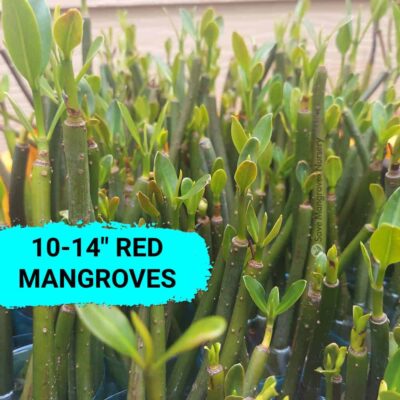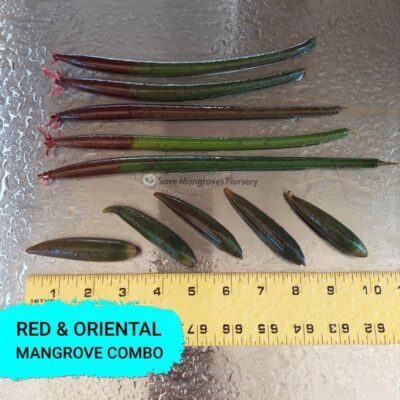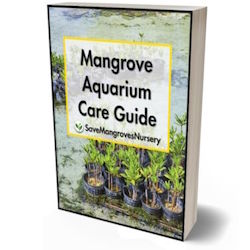If you’ve ever marveled at the beauty of mangroves in their natural coastal habitats, you might wonder if these fascinating plants can thrive in your home aquarium. As a professional aquarium enthusiast and the owner of Save Mangroves Nursery, I’ve had the joy of helping countless hobbyists introduce mangroves into their aquatic setups. Let me tell you, it’s not only possible, but it’s also incredibly rewarding.
Why Grow Mangroves in a Fish Tank?
Mangroves are not just ordinary plants; they are nature’s powerhouses. These resilient plants can tolerate a range of conditions, making them a great addition to various types of aquariums.
Natural Filtration
One of the main reasons people add mangroves to their aquariums is for their natural filtration capabilities. Mangroves absorb nutrients like nitrates, phosphates, and other pollutants, effectively purifying the water. This helps maintain water quality, reducing the need for chemical filters and keeping your aquatic inhabitants happy and healthy.
Aesthetic Appeal
Mangroves add a unique and exotic aesthetic to any aquarium. Their twisted roots and vibrant green leaves create a natural and wild look that mimics a coastal environment. Whether you’re setting up a saltwater, freshwater, or brackish tank, mangroves can become the centerpiece that transforms your tank into a living work of art.
Mangrove Facts
🛑 Did You Know? Mangroves can live for over 100 years in their natural habitat, making them one of the longest-living coastal plants. This longevity can translate to years of beauty and functionality in your aquarium as well.
What Type of Tank Is Suitable?
Mangroves are versatile, but not every tank setup is ideal for their growth. Here’s a breakdown:
Saltwater Tanks
Mangroves naturally thrive in coastal areas where saltwater is prevalent. Saltwater tanks can mimic their natural environment, making them a suitable choice. However, it’s important to monitor salinity levels and ensure they are stable.
- ✅ Good: Mangroves thrive in saltwater, where they can absorb nutrients and help stabilize water quality.
- ❌ Bad: High salinity fluctuations can stress the plants, so consistent monitoring is necessary.
Freshwater Tanks
Yes, mangroves can survive in freshwater tanks, but they might not grow as vigorously as they would in brackish or saltwater. Freshwater tanks require more careful management, particularly regarding nutrient availability.
- ✅ Good: Mangroves can survive in freshwater and still provide filtration benefits.
- ❌ Bad: Growth may be slower, and nutrient deficiencies are more common, requiring supplemental feeding.
Brackish Tanks
Brackish tanks, with their mix of salt and freshwater, are often the sweet spot for mangroves. They provide an environment that closely resembles the mangrove’s natural habitat.
- ✅ Good: Balanced environment that supports healthy growth and natural filtration.
- ❌ Bad: Requires careful maintenance of salinity levels, which can fluctuate in brackish tanks.
Setting Up Your Tank for Mangrove Growth
Lighting Requirements
Mangroves need adequate lighting to perform photosynthesis. This means that standard aquarium lights may not suffice. LED lights that replicate natural sunlight are ideal. In my experience, providing 10-12 hours of light per day helps mimic the day/night cycle and promotes healthy growth.
Substrate Considerations
While mangroves don’t necessarily need a substrate to grow, planting them in sand or mud can help anchor them and provide stability. However, mangroves can also grow while suspended in water, with roots freely extending downwards. This setup not only looks cool but also showcases their unique root system.
Mangrove Facts
🛑 Did You Know? Mangroves can absorb and excrete excess salt through their leaves, making them highly adaptable to different salinity levels.
Good vs. Bad: Pros and Cons of Growing Mangroves in a Fish Tank
Let’s break down the pros and cons to help you decide if mangroves are right for your aquarium:
- ✅ Good: Natural filtration reduces the need for chemical filters, creating a more natural environment.
- ✅ Good: Aesthetic enhancement adds a unique and exotic touch to your aquarium.
- ✅ Good: Mangroves can help stabilize pH levels, creating a more balanced environment for fish.
- ❌ Bad: Requires specific lighting and possibly supplemental nutrients, increasing maintenance.
- ❌ Bad: Growth can be slow in non-brackish tanks, leading to potential frustration for some hobbyists.
- ❌ Bad: Mangroves can grow quite large, so they may eventually outgrow smaller tanks.
Caring for Mangroves in Your Aquarium
Water Changes and Stability
Mangroves are quite resilient, but like all plants, they need a stable environment to thrive. Regular water changes are crucial, especially in smaller tanks where nutrient levels can fluctuate rapidly. However, be careful not to make changes too drastic, as sudden shifts in water parameters can stress the mangroves.
Pruning and Maintenance
Mangroves can grow quite large, so pruning might be necessary to keep them manageable within your tank. Trimming the leaves and roots not only controls their size but also encourages more robust growth. In my years of growing mangroves, I’ve found that regular pruning not only keeps the plants healthy but also prevents them from overshadowing other plants in the tank.
Mangrove Facts
🛑 Did You Know? Mangroves are known as “walking trees” because they can move their root system over time, creating new land in their natural habitat. While they won’t walk out of your tank, their roots will spread and grow to fill the available space.
Conclusion: Is Growing Mangroves in Your Fish Tank Worth It?
Absolutely! Growing mangroves in your fish tank can be a fulfilling experience, combining the beauty of these plants with their practical benefits. Whether you’re looking to create a natural filtration system, enhance the aesthetic appeal of your aquarium, or simply try something new, mangroves are a fantastic choice.
At Save Mangroves Nursery, we offer healthy Live Red Mangrove Plants ready to be added to your Saltwater, Freshwater, or Brackish Aquarium tanks. We ship out daily to all 50 states, ensuring that your new mangroves arrive in perfect condition, ready to transform your aquarium.
Whether you’re a seasoned aquarist or just starting out, mangroves can bring a touch of the wild coast into your home, all while keeping your aquarium healthy and thriving. So why not give them a try? With the right care, your mangroves will grow and flourish, providing you with years of enjoyment and satisfaction.
Best seller products
-
18”-24” Red Mangroves With Roots & 2-4 Leaves
Price range: $34.99 through $87.99 -
10”-14” Red Mangroves With Roots & 2-4 Leaves
Price range: $19.99 through $47.99 -
28″ Red Mangrove Tree – Fully Mature Plant
Price range: $0.00 through $230.00 -
[RARE] Orange Oriental Mangroves Propagule Seeds
Price range: $19.99 through $79.99 -
30″ Red Mangrove Tree – Fully Mature Plant
Price range: $0.00 through $180.00 -
Red & Oriental Mangrove Combo Bundle
Price range: $29.99 through $44.99
 Cart is empty
Cart is empty 




![[RARE] Orange Oriental Mangroves Propagule Seeds](https://savemangroves.com/wp-content/uploads/2025/07/Oriental-Mangrove-Seeds-Save-Mangroves-Nursery-400x400.jpg)



Add a Comment
You must be logged in to post a comment